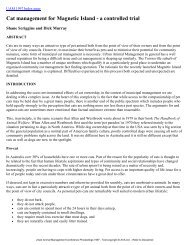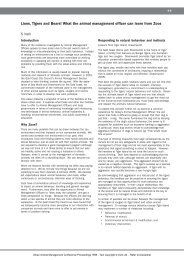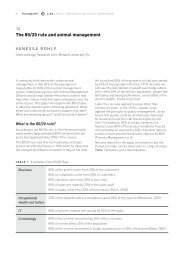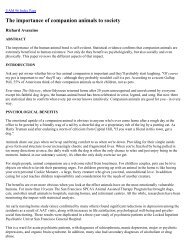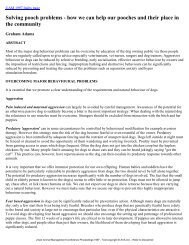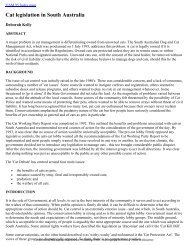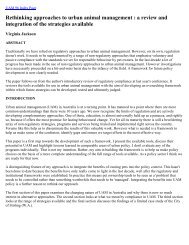Proceedings OF ThE - Australian Institute of Animal Management Inc
Proceedings OF ThE - Australian Institute of Animal Management Inc
Proceedings OF ThE - Australian Institute of Animal Management Inc
You also want an ePaper? Increase the reach of your titles
YUMPU automatically turns print PDFs into web optimized ePapers that Google loves.
84 <strong>Proceedings</strong> 2012<br />
AIAM Annual Conference on <strong>Animal</strong> <strong>Management</strong><br />
14<br />
The 80/20 rule and animal management<br />
Vanessa Rohlf<br />
Anthrozoology Research Unit, Monash University Vic<br />
A commonly held idea within urban animal<br />
management is that 20% <strong>of</strong> the population is<br />
responsible for 80% <strong>of</strong> the animal management<br />
issues. Indeed discussions with <strong>Animal</strong> <strong>Management</strong><br />
Officers and <strong>Animal</strong> Shelter Personnel confirm that<br />
they <strong>of</strong>ten interact with the same individuals over the<br />
same issues. This paper will explore the 80/20 idea<br />
in detail by answering the following questions: What<br />
empirical evidence do we have to support this idea?<br />
What are we doing about it? and Can we do it better?<br />
What is the 80/20 rule?<br />
According to the 80/20 rule, or the Pareto principle,<br />
many events (approximately 80%) are derived from<br />
just a few (approximately 20%) <strong>of</strong> the causes.<br />
The 80/20 rule was first formulated by an Italian<br />
economist Vilfredo Pareto in 1906 when he observed<br />
the unequal distribution <strong>of</strong> wealth in Italy at the time.<br />
He found that 80% <strong>of</strong> the property in Italy was owned<br />
by 20% <strong>of</strong> the population (Pareto, 1971). Actually we<br />
still see this distribution <strong>of</strong> wealth even today where<br />
the richest 20% <strong>of</strong> the world’s population, people like<br />
Bill Gates and Georgina Rinehart, control 80% <strong>of</strong> the<br />
world’s wealth. Pretty scary huh!<br />
Later the rule was applied to areas other than<br />
economics when, in the 1940’s, Joseph Juran<br />
applied the principle to quality management. Juran<br />
found that quality could be dramatically improved<br />
by focusing on just the vital few and ignoring the<br />
rest. For example, 20% <strong>of</strong> product defects in a<br />
factory cause 80% <strong>of</strong> the product problems thus by<br />
concentrating on solving the 20% <strong>of</strong> product defects<br />
product issues would theoretically improve by 80%<br />
(Pinnicle <strong>Management</strong>, n.d).<br />
Not only does this rule apply to economics but the<br />
Pareto principle can be observed in a range <strong>of</strong> areas.<br />
Table 1 presents just a few examples.<br />
Table 1 Examples <strong>of</strong> the 80/20 Rule<br />
Business<br />
Occupational<br />
Health and Safety<br />
IT<br />
Criminology<br />
80% <strong>of</strong> the pr<strong>of</strong>its come from 20% <strong>of</strong> the customers<br />
80% <strong>of</strong> complaints come from 20% <strong>of</strong> customers<br />
80% <strong>of</strong> pr<strong>of</strong>its come from 20% <strong>of</strong> your time<br />
80% <strong>of</strong> sales are made by 20% <strong>of</strong> the sales staff<br />
80% <strong>of</strong> sales come from 20% <strong>of</strong> the products (Koch, 2008)<br />
20% <strong>of</strong> the hazards within a workplace cause 80% <strong>of</strong> the injuries (Woodcock, 2010)<br />
80% <strong>of</strong> system crashes are caused by 20% <strong>of</strong> the faults<br />
80% <strong>of</strong> the crimes committed by 20% <strong>of</strong> the criminals<br />
80% <strong>of</strong> crimes affect 20% <strong>of</strong> the population<br />
80% <strong>of</strong> the crimes committed in single location occur in 20% <strong>of</strong> that area (Boba, 2005)



